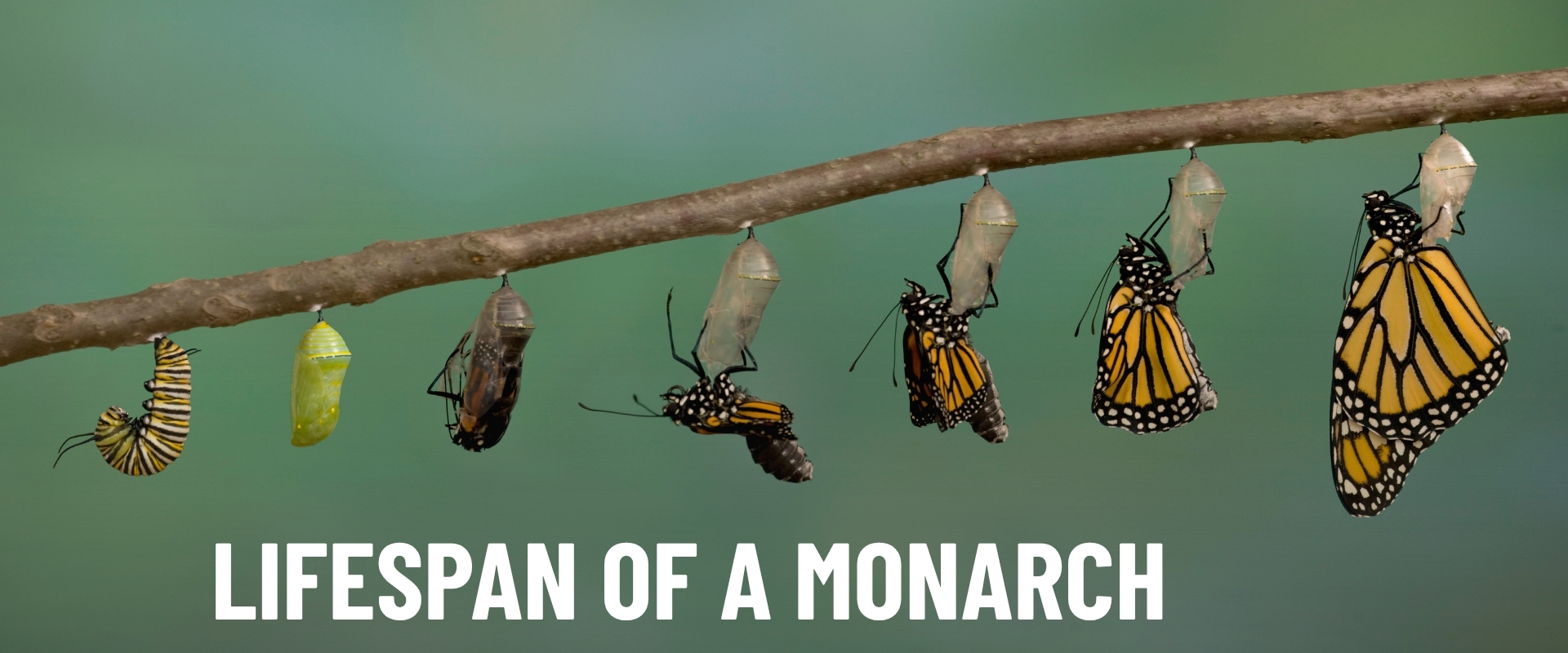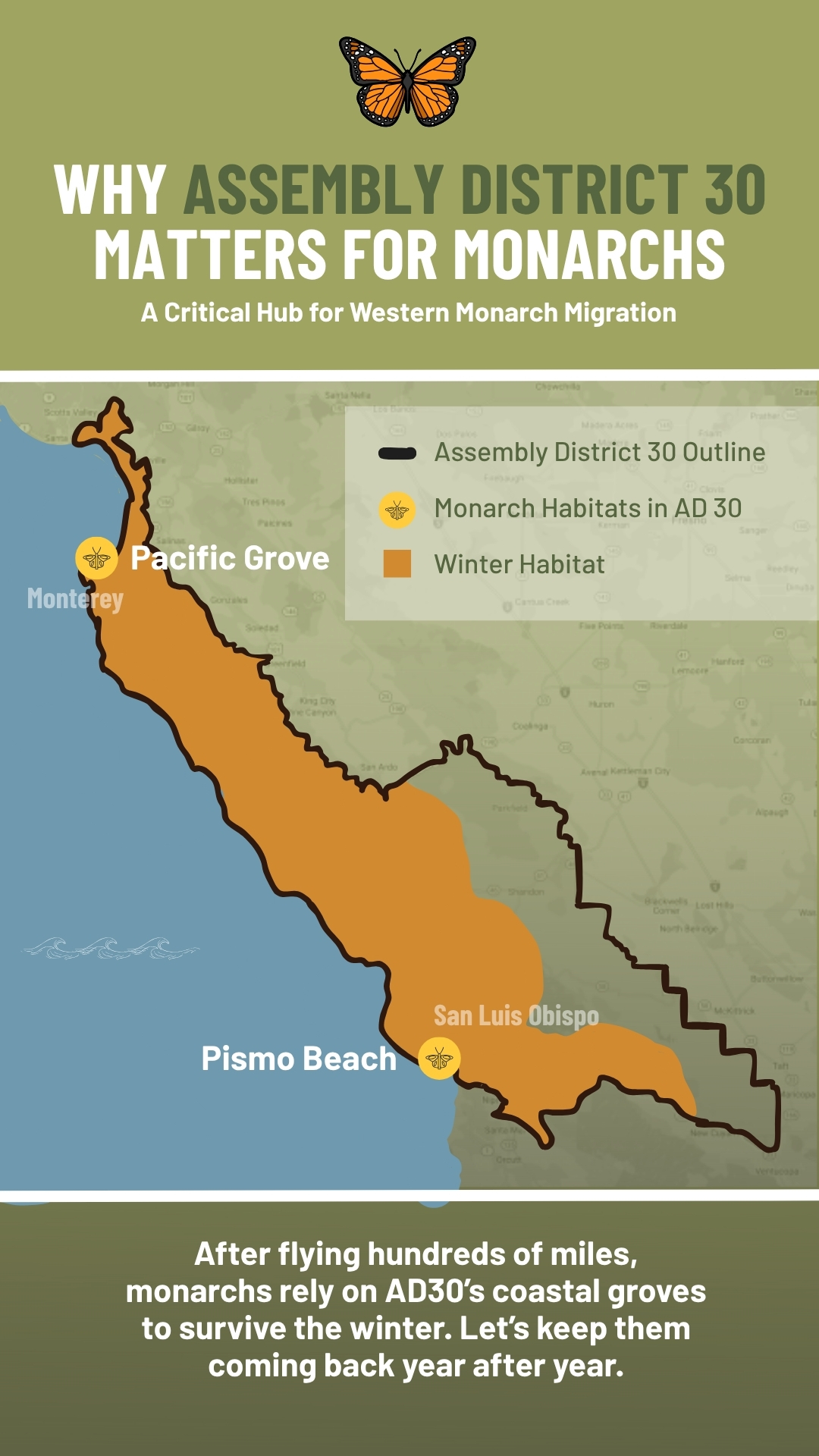Every winter, thousands of monarchs choose our coastal groves as their safe haven. Their future depends on what we do now.

Western monarch butterflies make one of nature’s most extraordinary migrations, returning to California’s coastal groves each winter. Yet the western monarch butterfly population has declined by more than 80%, placing them at risk of extinction by 2080 if urgent action is not taken
That’s why I introduced ACR 103, officially proclaiming California Western Monarch Protection Week. Through ACR 103, I’m raising awareness about the urgent need to protect more than 400 overwintering sites statewide and inspiring Californians to take action. It encourages every Californian to help safeguard these iconic pollinators, vital to biodiversity, climate resilience, and the Central Coast’s tourism economy.
Read below to find out how you can help, what to know about monarchs, and where to go to experience these incredible butterflies for yourself.

What Are Overwintering Groves and Why Do They Matter?
Protecting these overwintering groves is essential—they’re the only safe places monarchs can rest, recover, and continue their life cycle.

Map from California State Parks Foundation indicating the Western Monarch Migration.
🔗 Learn more about the migration from CA State Parks Foundation

Whereas the entire life cycle of a northward-traveling monarch butterfly takes only between 2 and 5 weeks to complete, the lifespan of a southward-migrating monarch butterfly can be as long as 8 to 9 months.
Here’s what that looks like:
- Summer Generations: Monarchs born in spring and summer live only a few weeks. Their sole purpose is to mate, lay eggs on milkweed, and continue the migration north. Several generations are born this way, each moving the migration farther along.
- Winter Generation (Overwintering Monarchs): The final generation of the year—the butterflies we see clustering in California’s coastal groves—enters a special state called diapause, which allows them to live through the winter. These monarchs can survive for 6 to 8 months, resting, conserving energy, and feeding on nectar until it’s time to head north in late February or early March.
This incredible cycle means the monarchs that return to the Central Coast each winter are not the same ones that left in spring—they’re often the great-great-grandchildren of last year’s butterflies, guided by instincts we still don’t fully understand.
From the Assemblymember
Assemblymember Addis presents ACR 103 on the Assembly floor on Monday, July 14, 2025
“The Central Coast is proud to serve as a winter home for the Western Monarch Butterfly—an iconic species whose survival is tied to the health of our environment, local economies, and cultural heritage. Protecting these overwintering sites is both a conservation priority and a community responsibility.” — Asm. Dawn Addis
Why the Western Monarch Matters
The Western monarch is more than just a butterfly—it’s a symbol of migration, resilience, and the health of our environment. Protecting monarchs means protecting California’s natural heritage.
Here’s why they’re so important:
🦋 Vital pollinators that help keep our ecosystems healthy
🌿 Depend on native milkweed and pesticide-free habitats to survive
🧭 Their annual migration is one of nature’s most remarkable journeys
💸 They boost eco-tourism, bringing visitors to our coastal communities each winter
When we protect monarchs, we protect biodiversity, support local economies, and pass on a healthier environment to future generations.
State Legislative Action to Protect Monarchs
- ACR 103 – California Western Monarch Protection Week (July 14-18, 2025)
- AB 1243 – Polluters Pay Climate Superfund Act (2025)
- AB 1407 – Ocean Ecosystem Recovery (2023)
- AB 720 – Grassland Restoration Program (2023)
Note: Some bills are two-year efforts or did not advance, but all represent critical components of a long-term habitat strategy.
Monarch Habitats in Assembly District 30

Protecting these sites isn’t just conservation—it’s part of who we are as a community. I’m proud that Assembly District 30 is home to some of California’s most critical overwintering sites.
Here’s a look at the key habitats in our district:
📍 Pacific Grove Monarch Grove Sanctuary:
- 2023 Peak Count: 7,663 butterflies
- Hosted 2.8% of California’s monarch population in 2023–24
- Almost consistently ranked in the Top 10 overwintering sites statewide
📍 Pismo State Beach Monarch Grove:
- 2022–23: 24,128 monarchs
- 2023–24: 16,347 monarchs
- 2024–25: Only 556 monarchs counted so far
- One of the largest publicly owned monarch groves in the U.S.
📍 Monterey County Coastal Groves:
- MGS alone has averaged 37% of Monterey County’s population since 2001
- Many coastal groves are on private land and remain vulnerable to development
These sites are living treasures—and their future depends on what we do now.
How You Can Help
Protecting monarchs is a shared responsibility, and every small action makes a difference. Here’s how you can join me in helping:
🌱 Plant native milkweed (While planting native milkweed is essential for monarch survival, it should never be planted within five miles of the coast, where it can interfere with their natural migratory behavior.)
🚫 Avoid pesticides that harm butterflies and other pollinators
🏞 Visit and support local sanctuaries—your presence helps fund conservation
🗳 Advocate for legislation that protects pollinators and climate-resilient habitats
I’ve included a few resources below to help you get started, whether you’re planting a butterfly-friendly garden or planning a visit to one of our coastal sanctuaries.
Planting Guide – Xerces Society
In the News
📰 California State Parks Foundation: Near-Record Low Monarch Counts
Western monarch numbers are in steep decline—scientists and advocates call for urgent habitat protections.
📰 Saving the Western Monarch – Cal Parks Blog
A closer look at how local and state partnerships are working to reverse population loss.
Learn More + Share
Together, we can protect these extraordinary butterflies. Share this page, visit a sanctuary, and join me in making sure monarchs return to our coast year after year.
🔗 Read the ACR 103 Proclamation
SOURCES:
https://westernmonarchcount.org/
https://www.activewild.com/life-cycle-of-the-monarch-butterfly/